The T 34 is a 32.78ft fractional sloop designed by Lostuzzi Yacht Design and built in fiberglass by T-Yachts (ITA) since 2011.
The T 34 is a light sailboat which is a very high performer. It is stable / stiff and has a low righting capability if capsized. It is best suited as a racing boat. The fuel capacity is originally very small. There is a very short water supply range.
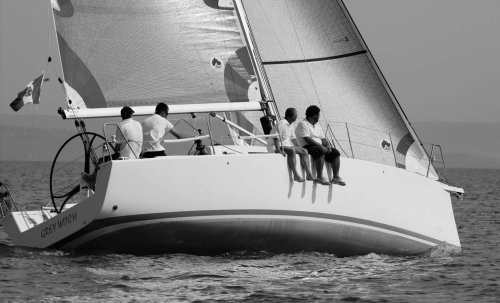

T 34 for sale elsewhere on the web:

Main features
| Model | T 34 | ||
| Length | 32.78 ft | ||
| Beam | 10.83 ft | ||
| Draft | 7.22 ft | ||
| Country | Italy (Europe) | ||
| Estimated price | $ 0 | ?? |
Login or register to personnalize this screen.
You will be able to pin external links of your choice.

See how Sailboatlab works in video
| Sail area / displ. | 28.52 | ||
| Ballast / displ. | 36.48 % | ||
| Displ. / length | 149.31 | ||
| Comfort ratio | 17.52 | ||
| Capsize | 2.16 |
| Hull type | Monohull fin keel with bulb and spade rudder | ||
| Construction | Fiberglass | ||
| Waterline length | 29 ft | ||
| Maximum draft | 7.22 ft | ||
| Displacement | 8157 lbs | ||
| Ballast | 2976 lbs | ||
| Hull speed | 7.22 knots |

We help you build your own hydraulic steering system - Lecomble & Schmitt
| Rigging | Fractional Sloop | ||
| Sail area (100%) | 720 sq.ft | ||
| Air draft | 0 ft | ?? | |
| Sail area fore | 282.43 sq.ft | ||
| Sail area main | 335.32 sq.ft | ||
| I | 44.13 ft | ||
| J | 12.80 ft | ||
| P | 42.58 ft | ||
| E | 15.75 ft |
| Nb engines | 1 | ||
| Total power | 18 HP | ||
| Fuel capacity | 16 gals |
Accommodations
| Water capacity | 32 gals | ||
| Headroom | 0 ft | ||
| Nb of cabins | 0 | ||
| Nb of berths | 0 | ||
| Nb heads | 0 |
Builder data
| Builder | T-Yachts (ITA) | ||
| Designer | Lostuzzi Yacht Design | ||
| First built | 2011 | ||
| Last built | 0 | ?? | |
| Number built | 0 | ?? |
Other photos
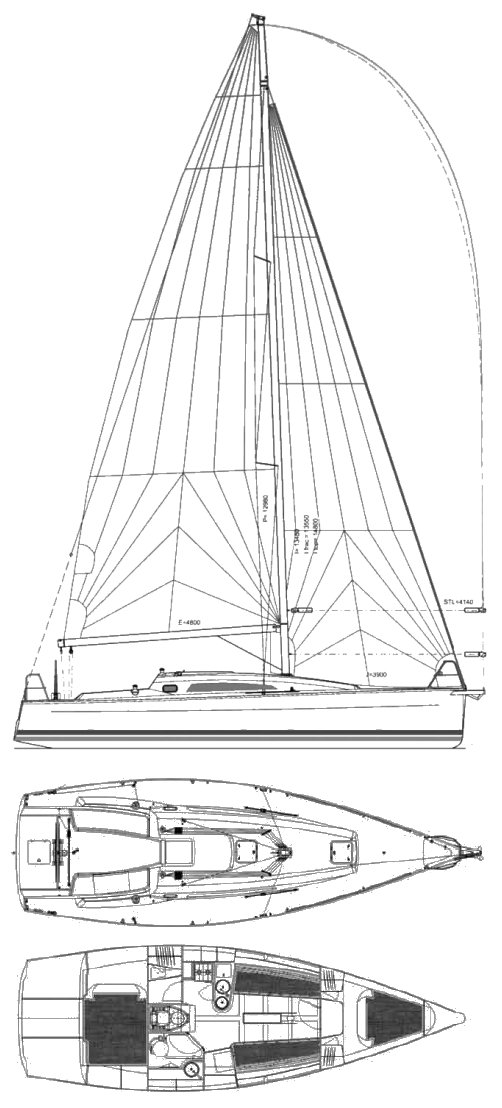
Modal Title
The content of your modal.
Personalize your sailboat data sheet
Review of T-34

Basic specs.
The hull is made of fibreglass. Generally, a hull made of fibreglass requires only a minimum of maintenance during the sailing season. And outside the sailing season, just bottom cleaning and perhaps anti-fouling painting once a year - a few hours of work, that's all. The hull is a double hull which improves the indoor climate. Especially when the water is colder than the air in the cabin, then the double hull insulates against cold water and reduce the condense water in the cabin.
The boat is equipped with 4+2 berths and 120.0 liter fresh water capacity.

The boat equipped with a fractional rig. A fractional rig has smaller headsails which make tacking easier, which is an advantage for cruisers and racers, of course. The downside is that having the wind from behind often requires a genaker or a spinnaker for optimal speed.
Sailing characteristics
This section covers widely used rules of thumb to describe the sailing characteristics. Please note that even though the calculations are correct, the interpretation of the results might not be valid for extreme boats.
What is Capsize Screening Formula (CSF)?
The capsize screening value for T-34 is 2.15, indicating that this boat would not be accepted to participate in ocean races.
T-34 holds one CE certification:
What is Theoretical Maximum Hull Speed?
The theoretical maximal speed of a displacement boat of this length is 7.2 knots. The term "Theoretical Maximum Hull Speed" is widely used even though a boat can sail faster. The term shall be interpreted as above the theoretical speed a great additional power is necessary for a small gain in speed.
The immersion rate is defined as the weight required to sink the boat a certain level. The immersion rate for T-34 is about 195 kg/cm, alternatively 1094 lbs/inch. Meaning: if you load 195 kg cargo on the boat then it will sink 1 cm. Alternatively, if you load 1094 lbs cargo on the boat it will sink 1 inch.
Sailing statistics
This section is statistical comparison with similar boats of the same category. The basis of the following statistical computations is our unique database with more than 26,000 different boat types and 350,000 data points.
What is Motion Comfort Ratio (MCR)?
What is L/B (Length Beam Ratio)?
What is Displacement Length Ratio?
What is SA/D (Sail Area Displacement ratio)?
Maintenance
Are your sails worn out? You might find your next sail here: Sails for Sale
If you need to renew parts of your running rig and is not quite sure of the dimensions, you may find the estimates computed below useful.
| Usage | Length | Diameter | ||
| Mainsail halyard | 33.8 m | (110.7 feet) | 10 mm | (3/8 inch) |
| Jib/genoa halyard | 33.8 m | (110.7 feet) | 10 mm | (3/8 inch) |
| Spinnaker halyard | 33.8 m | (110.7 feet) | 10 mm | (3/8 inch) |
| Jib sheet | 10.0 m | (32.8 feet) | 12 mm | (1/2 inch) |
| Genoa sheet | 10.0 m | (32.8 feet) | 12 mm | (1/2 inch) |
| Mainsheet | 25.0 m | (81.9 feet) | 12 mm | (1/2 inch) |
| Spinnaker sheet | 22.0 m | (72.1 feet) | 12 mm | (1/2 inch) |
| Cunningham | 4.8 m | (15.7 feet) | 10 mm | (3/8 inch) |
| Kickingstrap | 9.6 m | (31.5 feet) | 10 mm | (3/8 inch) |
| Clew-outhaul | 9.6 m | (31.5 feet) | 10 mm | (3/8 inch) |
This section is reserved boat owner's modifications, improvements, etc. Here you might find (or contribute with) inspiration for your boat.
Do you have changes/improvements you would like to share? Upload a photo and describe what you have done.
We are always looking for new photos. If you can contribute with photos for T-34 it would be a great help.
If you have any comments to the review, improvement suggestions, or the like, feel free to contact us . Criticism helps us to improve.
T-34 - T-Yachts / STW003574
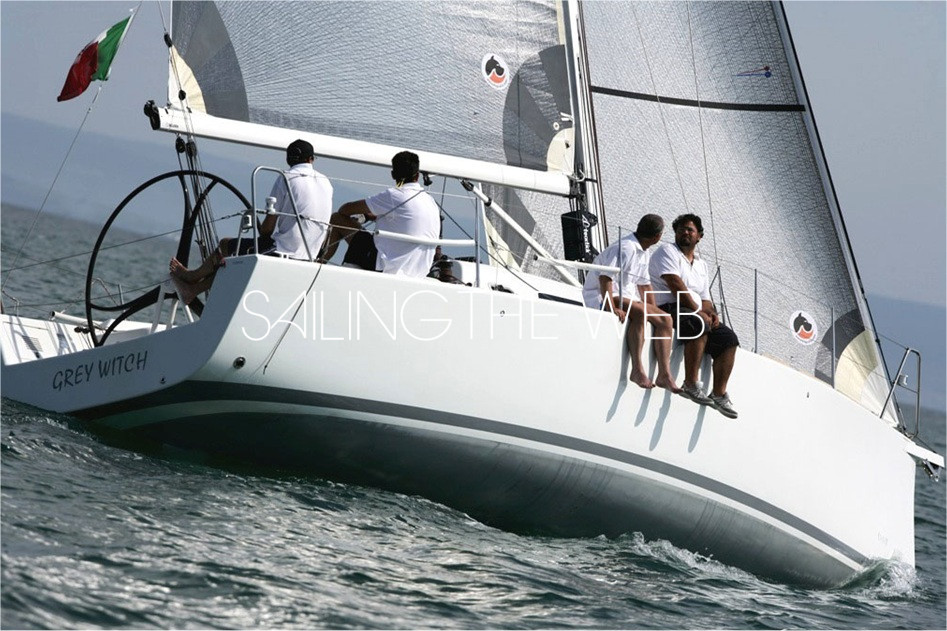
cabin cruiser
cruising/regatta
yanmar 20hp
overall length
hull length
waterline length
standard draft
minimum draft
displacement
diesel tank
mast height
Accomodation layouts
standard version
DOCUMENTS: T-34

If you find some wrong or lacking data of this boat, you can propose an update.
Technical forum: t-34, note: you will be redirected to another website., support the ultimate sailboat database.
The contents on this website, which today you can simply consult and use, have been collected, organized and archived by people who worked and invested in this project with passion and dedication for many years.
Before proceeding to browse, support our archive with a small donation that will allow us to maintain and improve this project.
proceed, I will donate next time
To proceed, you need to sign-in
Great choice! Your favorites are temporarily saved for this session. Sign in to save them permanently, access them on any device, and receive relevant alerts.
- Sailboat Guide
1988 Catalina 34
- Description
Seller's Description
The 1988 Catalina 34 sailboat is a classic style that has stood the test of time. Measuring 34’ 6”, this sailboat offers ample space for a comfortable and enjoyable sailing experience.
The cockpit is roomy and well laid out, with all the necessary controls easily accessible to the helmsman. The steering wheels folds for extra room.
The sailboat has a sleek design with a light tan hull, a blue stripe, and a tan-colored non-slip deck! The sails are covered in royal blue canvas. The rear bimini is also royal blue and adequately covers the captain and guests! The dodger is great with a clear view of the bow!
The boat’s interior is spacious, well-lit cabin that accommodates up to six people. The cabin is well-appointed, with a fully equipped galley, stove, ice box, sink, and storage cabinets.
There is a comfortable settee, a dinette, a forward double berth, and an aft double berth that is comfortable and has an opening portlight to the cockpit.
There is a private head compartment with a shower, sink, and a head. Lots of room to shower and clean up after a day on the water.
The Catalina 34 sailboat is equipped with a Universal M25 engine.
Overall, the 1988 Catalina 34 sailboat is a perfect choice for a classic, well-built sailboat that offers comfort, style, and performance.
The seller will finance with a minimum of 5k down at $500 a month at 5% interest and 36 months
Rig and Sails
Auxilary power, accomodations, calculations.
The theoretical maximum speed that a displacement hull can move efficiently through the water is determined by it's waterline length and displacement. It may be unable to reach this speed if the boat is underpowered or heavily loaded, though it may exceed this speed given enough power. Read more.
Classic hull speed formula:
Hull Speed = 1.34 x √LWL
Max Speed/Length ratio = 8.26 ÷ Displacement/Length ratio .311 Hull Speed = Max Speed/Length ratio x √LWL
Sail Area / Displacement Ratio
A measure of the power of the sails relative to the weight of the boat. The higher the number, the higher the performance, but the harder the boat will be to handle. This ratio is a "non-dimensional" value that facilitates comparisons between boats of different types and sizes. Read more.
SA/D = SA ÷ (D ÷ 64) 2/3
- SA : Sail area in square feet, derived by adding the mainsail area to 100% of the foretriangle area (the lateral area above the deck between the mast and the forestay).
- D : Displacement in pounds.
Ballast / Displacement Ratio
A measure of the stability of a boat's hull that suggests how well a monohull will stand up to its sails. The ballast displacement ratio indicates how much of the weight of a boat is placed for maximum stability against capsizing and is an indicator of stiffness and resistance to capsize.
Ballast / Displacement * 100
Displacement / Length Ratio
A measure of the weight of the boat relative to it's length at the waterline. The higher a boat’s D/L ratio, the more easily it will carry a load and the more comfortable its motion will be. The lower a boat's ratio is, the less power it takes to drive the boat to its nominal hull speed or beyond. Read more.
D/L = (D ÷ 2240) ÷ (0.01 x LWL)³
- D: Displacement of the boat in pounds.
- LWL: Waterline length in feet
Comfort Ratio
This ratio assess how quickly and abruptly a boat’s hull reacts to waves in a significant seaway, these being the elements of a boat’s motion most likely to cause seasickness. Read more.
Comfort ratio = D ÷ (.65 x (.7 LWL + .3 LOA) x Beam 1.33 )
- D: Displacement of the boat in pounds
- LOA: Length overall in feet
- Beam: Width of boat at the widest point in feet
Capsize Screening Formula
This formula attempts to indicate whether a given boat might be too wide and light to readily right itself after being overturned in extreme conditions. Read more.
CSV = Beam ÷ ³√(D / 64)
Total Catalina 34’s built: 1,438 Shoal draft: 4.67’.
1985-1986: Deck stepped mast; Universal 25 (21HP) diesel engine. 1987-1990: Changed to keel stepped mast; Universal 25XP (23 HP) engine. 1990-1991: Walk-through transom introduced; Universal M35 (30 HP).
The last Mark I models look very much like Mark IIs. (see CATALINA 34 MKII)
Wing keel: Draft = 3.83’.
Tall Rig: I: 46.0’ J: 13.5’ P: 40.5’ E: 12.0’
Photo courtesy Adam Hunt.
This listing is presented by PopYachts.com . Visit their website for more information or to contact the seller.
View on PopYachts.com
Embed this page on your own website by copying and pasting this code.
Similar Sailboats For Sale

1990 Catalina 34 Tall Rig

1990 Catalina Mk 1 Tall Rig

1987 Catalina Catalina 34

1988 Catalina 34 Sloop

- About Sailboat Guide
©2024 Sea Time Tech, LLC
This site is protected by reCAPTCHA and the Google Privacy Policy and Terms of Service apply.
- Types of Sailboats
- Parts of a Sailboat
- Cruising Boats
- Small Sailboats
- Design Basics
- Sailboats under 30'
- Sailboats 30'-35
- Sailboats 35'-40'
- Sailboats 40'-45'
- Sailboats 45'-50'
- Sailboats 50'-55'
- Sailboats over 55'
- Masts & Spars
- Knots, Bends & Hitches
- The 12v Energy Equation
- Electronics & Instrumentation
- Build Your Own Boat
- Buying a Used Boat
- Choosing Accessories
- Living on a Boat
- Cruising Offshore
- Sailing in the Caribbean
- Anchoring Skills
- Sailing Authors & Their Writings
- Mary's Journal
- Nautical Terms
- Cruising Sailboats for Sale
- List your Boat for Sale Here!
- Used Sailing Equipment for Sale
- Sell Your Unwanted Gear
- Sailing eBooks: Download them here!
- Your Sailboats
- Your Sailing Stories
- Your Fishing Stories
- Advertising
- What's New?
- Chartering a Sailboat
- Cruising Yachts 30' to 35'
The S&S 34 Sailboat
The S&S 34 is a cruising and racing fibreglass monohull sailboat that was designed by Olin Stephens from Sparkman and Stephens. It has a skeg-hung rudder and a Bermuda rig with a large, overlapping headsail. It is a proven cruising yacht that is well suited for short-handed sailing, and also a successful racing yacht that has won many prestigious events.
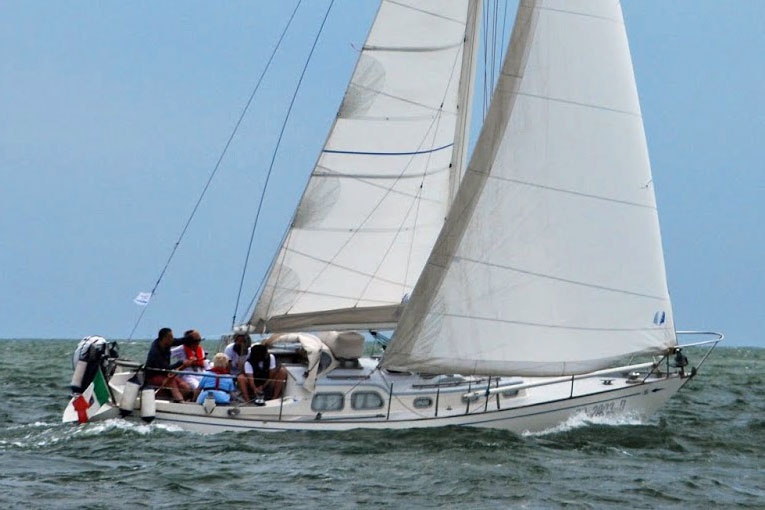
Published Specification for the S&S 34
Underwater Profile: Fin keel & Skeg-Hung Rudder;
Hull Material: GRP (Fiberglass);
Length Overall: 33'5" (10.2m);
Waterline Length: 24'2" (7.4m);
Beam: 10'1" (3.1m);
Draft: 5'9" (1.8m);
Rig Type: Masthead sloop;
Displacement: 9,195lb / 4,171kg;
Designer: Sparkman & Stephens;
Builder: Winfield & Partners/Aquafibre (UK);
Year First Built: 1968;
Owners Association: Sparkman & Stephens Owners Association
Sail Areas & Rig Dimensions
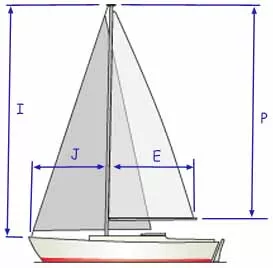
I: 12.2 m (40.0 ft) J: 4.0 m (13.1 ft) P: 10.7 m (35.1 ft) E: 3.4 m (11.2 ft)
Mainsail Area: 17.9 m² (192.5 ft²) Foresail Area: 24.2 m² (260.5 ft²) Total Sail Area: 42.1 m² (452.5 ft²).
Published Design Ratios for the S&S 34
- Sail Area/Displacement Ratio: 16.5 - The S&S 34 has a Sail Area/Displacement Ratio of 16.5. This indicates that the boat has reasonably good performance capability. It is not underpowered and suggests it can maintain a decent speed and agility under sail. This ratio falls into the range that indicates reasonably good performance (16 to 20).
- Ballast/Displacement Ratio: 58.7 - With a Ballast/Displacement Ratio of 58.7%, the S&S 34 is quite stiff, implying that it can stand up well to strong winds without excessive heeling. This high ratio suggests the boat will be stable and perform well in various wind conditions. However, without information on the ballast's location, we can't fully assess its stiffness. A deeper keel with concentrated ballast would further enhance stability.
- Displacement/Length Ratio: 291 - The S&S 34 has a Displacement/Length Ratio of 291, placing it in the Heavy Displacement category (275-350). This means the boat is relatively heavy for its length and will require more sail area to reach hull speed compared to lighter displacement boats. Heavier displacement boats like this one are typically more comfortable in rough seas and provide a steadier ride.
- Comfort Ratio: 24.3 - The Comfort Ratio of 24.3 suggests that the S&S 34 will have moderate motion comfort. It falls within the range (20 to 30) typically associated with coastal cruisers with moderate stability. This indicates that the boat will handle the typical pitch, roll, and corkscrew motions encountered in coastal cruising quite well, providing a reasonable level of comfort for the crew.
- Capsize Screening Formula: 1.9 - With a Capsize Screening Formula of 1.9, the S&S 34 is well-suited for ocean passages. Since the value is at 2.0 or lower, it indicates the boat has good blue water capabilities and is less vulnerable to capsizing in rough offshore conditions. The lower the value, the better, and 1.9 suggests that the boat should handle well in heavy seas.
Summary: The S&S 34 sailboat is designed for good performance with decent speed and agility thanks to its Sail Area/Displacement Ratio. It has a high Ballast/Displacement Ratio, indicating good stability and stiffness, though the exact nature of its stability depends on ballast placement. Being a heavy displacement boat, the S&S 34 is expected to be comfortable in rough seas and provides a moderate level of motion comfort consistent with coastal cruising. Its Capsize Screening Formula underlines its suitability for blue water sailing, making it a solid choice for long ocean passages.
Design Ratios: Notes of Caution...
- The Sail Area/Displacement Ratio (SA/D): This ratio provides an estimate of the sail power relative to the boat's weight, which can indicate potential speed in various wind conditions. But i t doesn't account for the efficiency of the sail plan, the rigging, or the skill of the crew. Real-world performance can vary significantly based on these factors.
- The Ballast/Displacement Ratio (B/D): This ratio gives an idea of the boat's stability and stiffness, which is crucial for handling and safety. But it doesn't consider the distribution of the ballast or the hull shape, both of which can greatly affect stability. A high B/D ratio alone doesn't guarantee a stable boat if the ballast is poorly distributed.
- The Displacement/Length Ratio (D/L): This ratio helps predict the boat's speed potential and its behaviour in different sea conditions. But it doesn't account for the hull design or the boat's overall weight distribution. Two boats with the same D/L ratio can perform very differently if their hull shapes are different.
- The Comfort Ratio (CR): This ratio estimates the boat's motion comfort in a seaway, which is important for long passages. But it doesn't consider the boat's interior layout, which can also affect comfort. Additionally, personal tolerance to motion varies, so a boat that is comfortable for one person might not be for another.
- The Capsize Screening Formula (CSF): This formula assesses the likelihood of a boat capsizing in heavy seas, which is critical for offshore safety. But it doesn't take into account the boat's handling characteristics or the skill of the crew. A boat with a low CSF can still capsize if poorly handled in severe conditions.
General Limitations
- Static Nature: These ratios are static measurements and don't account for dynamic factors like wave action, wind gusts, or crew actions.
- Simplification: They simplify complex interactions into single numbers, which can be misleading. Real-world performance is influenced by a multitude of factors that these ratios can't fully capture.
- Context: The context in which the boat is used (e.g., coastal cruising vs. offshore racing) can greatly affect how these ratios should be interpreted.
In summary, while these ratios provide valuable insights into the theoretical performance characteristics of a sailboat, they should be used as part of a broader assessment that includes practical experience, sea trials, and expert advice.
The above text was drafted by sailboat-cruising.com using GPT-4 (OpenAI’s large-scale language-generation model) as a research assistant to develop source material; we believe it to be accurate to the best of our knowledge.
Recent Articles
GENERIC KPI Template
Aug 25, 24 07:21 AM
Gulfstar Hirsch 45 Sailboat Specs & Key Performance Indicators
Aug 25, 24 07:19 AM
Nicholson 35 Sailboat Specs & Key Performance Indicators
Aug 24, 24 02:27 PM
Here's where to:
- Find Used Sailboats for Sale...
- Find Used Sailing Gear for Sale...
- List your Sailboat for Sale...
- List your Used Sailing Gear...

Our eBooks...

A few of our Most Popular Pages...

Copyright © 2024 Dick McClary Sailboat-Cruising.com
































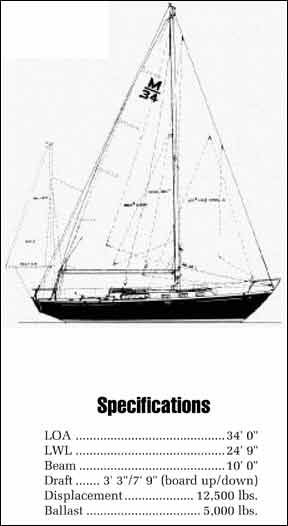
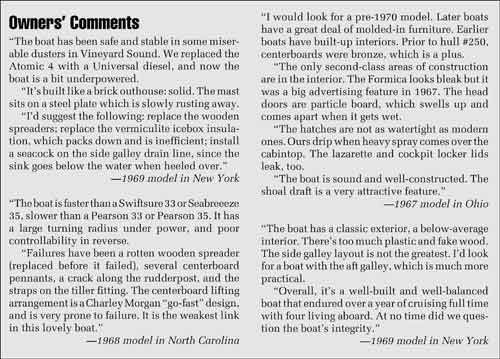
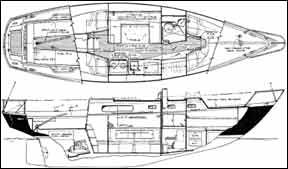





IMAGES
COMMENTS
40 to 50 indicates a heavy bluewater boat; over 50 indicates an extremely heavy bluewater boat. Comfort ratio = D ÷ (.65 x (.7 LWL + .3 LOA) x Beam^1.33), where displacement is expressed in pounds, and length is expressed in feet. Capsize Screening Formula (CSF): Designed to determine if a boat has blue water capability.
You'll find them wherever the water is shallow. Read this and weep: in 1970, a Tartan 34, complete with sails, cost about $22,000. By 1975, the price had gone all the way up to $29,000. Today, equipped with more modern equipment, the boat would cost $100,000 to build. Sailing Performance.
T-34 is a 32′ 9″ / 10 m monohull sailboat designed by Lostuzzi Yacht Design and built by T-Yachts starting in 2011. Great choice! Your favorites are temporarily saved for this session. Sign in to save them permanently, access them on any device, and receive relevant alerts. ... T-34 is a 32 ′ 9 ″ / 10 m ...
The T 34 is a 32.78ft fractional sloop designed by Lostuzzi Yacht Design and built in fiberglass by T-Yachts (ITA) since 2011. The T 34 is a light sailboat which is a very high performer. It is stable / stiff and has a low righting capability if capsized. It is best suited as a racing boat. The fuel capacity is originally very small.
1984 Hunter 34. US$21,832. Sunnybrook Yachts | Rothesay, New Brunswick. Request Info. <. 1. >. * Price displayed is based on today's currency conversion rate of the listed sales price. Boats Group does not guarantee the accuracy of conversion rates and rates may differ than those provided by financial institutions at the time of transaction.
The immersion rate is defined as the weight required to sink the boat a certain level. The immersion rate for T-34 is about 195 kg/cm, alternatively 1094 lbs/inch. Meaning: if you load 195 kg cargo on the boat then it will sink 1 cm. Alternatively, if you load 1094 lbs cargo on the boat it will sink 1 inch.
A 135% jib can more effectively be reduced to 110% than a 150% genoa can be reefed to 120%. Since the boat is sensitive to sail area, a good headsail roller furling system is a must, in our opinion. According to several owners, the Hunter 34 carries substantial weather helm in anything more than very light air.
The letter "C" has been adopted on the used boat market, "classic", identifying it as the first 34 from Tartan. The second TARTAN 34, which is also a S&S design, is commonly referred to as the TARTAN 34-2. There was an option (rarely selected) to substitute a pilot berth for the cabinet storage to port, over and outboard of the dinette.
The T-34 produced by the builder T-Yachts and designed by Studio Lostuzzi Beatrice Pecoraro, is a cabin cruiser for cruising/regatta, rigged Sloop ... read more on Sailing The Web, the ultimate sailboat database
11'. '. Ohio. $55,000. Description: This Tartan 34 is a beautifully maintained Tartan with many. upgrades. This is a proven classic with a turn of speed for club. racing or very accommodating for extended cruising in comfort.
At present, Tartan, a yacht brand has 104 yachts available for purchase on YachtWorld. This collection encompasses 31 newly built vessels as well as 73 pre-owned yachts, with all listings, handled by boat and yacht brokers, primarily concentrated in United States, Canada, Greece, Mexico and Portugal. The selection of models featured on ...
Find Catalina 34 boats for sale in your area & across the world on YachtWorld. Offering the best selection of Catalina boats to choose from.
The Catalina 34 sailboat is equipped with a Universal M25 engine. Overall, the 1988 Catalina 34 sailboat is a perfect choice for a classic, well-built sailboat that offers comfort, style, and performance. The seller will finance with a minimum of 5k down at $500 a month at 5% interest and 36 months. Advertisement. Specs.
The S&S 34 is a cruising and racing fibreglass monohull sailboat that was designed by Olin Stephens from Sparkman and Stephens. It has a skeg-hung rudder and a Bermuda rig with a large, overlapping headsail. It is a proven cruising yacht that is well suited for short-handed sailing, and also a successful racing yacht that has won many ...
The Type 39 torpedo boat was conceived as a general-purpose design, much larger than preceding German torpedo boats. [1] The boats had an overall length of 102.5 meters (336 ft 3 in) and were 97 meters (318 ft 3 in) long at the waterline.They had a beam of 10 meters (32 ft 10 in), a draft of 3.22 meters (10 ft 7 in) at deep load and displaced 1,294 metric tons (1,274 long tons) at standard ...
Exactly 1,800 Catalina 34s were built between the years 1991-1999, and the boat has gone through several iterations. The hull we focus on here is the relatively narrower one built between 1986 and 1995, generally referred to as the Mark 1, or Mark 1.5. The Catalina 34 sold between 1994 and 2001 (production run officially ended in 1999) is known ...
South Carolina. $82,500. Description: New on the Market! Sass-Sea is a husky, canoe-sterned semi-custom sailboat made by British Columbia's Randle Yacht Corporation. The Cape Marine Coast 34 provides a generous interior aimed at being a comfortable and secure haven from weather and sea a like. She combines power, beauty of the hull with a ...
34'. $ 32,500. Single Universal FWC Atomic 30 Diesel (24HP)with 450hrs since rebuild, 12000 BTU reverse cycle A/C unit, Heart 1500 watt Inverter that is wired into the A/C unit.Sleeps 6 in forward V-berth, aft quarter berth, and convertible dinette, electric head with holding tank, full galley with microwave, (2) ….
The interior is a good selling point in any of the three models. For its length overall, the Cal 34—which is really just over 33′ long—has a lot of interior volume. Headroom on centerline in the main cabin is 6′ 2″. The boat easily has as much interior space as older boats 3′ or more longer. Engine.
This vessel was designed and built by the T-Yachts shipyard in 2012. Key features 2012 T-Yachts T-34: length 10 meters, beam 3.3 meters, boat displacement 4,230 kilograms and max boat draft 2.2 meters. 1 x Yanmar engine: fuel type - diesel. With a fuel tank capacity of 60 liters, the 2012 T-Yachts T-34 can cover a distance .
34' J Boat. J/105. 2005. 34'. $ 149,900. An exceptionally fast cruiser-racer, high tech design, fun to sail. Hull # 640, commissioned June '05 on Lake Champlain, fresh water use only. For sale due to Owners' change in plans. Please call ahead to arrange to see this boat. ….
Jack Jensen, founder of Jensen Marine owned and regularly sailed a CAL 34. Later versions (2-34, 34-III) share the same hull but with different rigs and other details. Production of the final version continued until 1979. ... more powerful boat that will be better able to stand up to the wind. Bal./Disp = ballast (lbs)/ displacement (lbs)*100
The Morgan 34 is a typical late CCA-rule centerboarder. Charley Morgan specialized in this type of boat, which was favored under the rating rule and well-adapted to life in the shoal waters of the Florida coast and the Bahamas. By today's standards, the Morgan 34 is a small boat, comparable in accommodations to a lot of 30-footers.
Mr Lynch had brought together family, friends and colleagues for an idyllic holiday on his luxury boat: a sumptuous 56-metre (184ft) sailing yacht that won design awards and had the world's ...